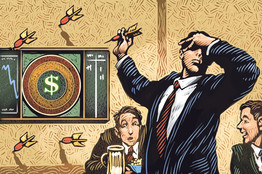 Great article in Baron’s on the challenges and hurdles facing those trying to manage risk to capital in investment markets. The long-always shills will no doubt cite this article as grounds for their ‘ buy and hold’ mantra, but actually the article is much better than that. The author cites studies showing that in the 20 years ended 2008 the average stock-fund investor averaged only a 1.9% annual return (due to consistently poor buy and sell decisions) [and very often at the recommendation of their equally inept and emotional financial advisors] even though the average stock mutual fund returned 8.4% annually over the same period.
Great article in Baron’s on the challenges and hurdles facing those trying to manage risk to capital in investment markets. The long-always shills will no doubt cite this article as grounds for their ‘ buy and hold’ mantra, but actually the article is much better than that. The author cites studies showing that in the 20 years ended 2008 the average stock-fund investor averaged only a 1.9% annual return (due to consistently poor buy and sell decisions) [and very often at the recommendation of their equally inept and emotional financial advisors] even though the average stock mutual fund returned 8.4% annually over the same period.
The fact is that humans are not emotionally wired to grin and bear great volatility in their life savings. Any approach that expects or assumes they will is not worthy. Losses are not only caused by selling in a panic near market bottoms, but are virtually assured by conventional approaches that buy and continue to hold equities at every price and through every phase of market cycles:
The huge losses from buying into popular asset manias near the top at high prices (with no safety margin in case of a decline) and the lost opportunities from selling temporarily unpopular but cheap assets at or near a bottom devastate long-term results because of the powerful effect of compounding, which multiplies the effect of large errors.
Moreover, investors who suffer these losses are generally hurt psychologically and are often too gun-shy for months or years after to pursue even sensible rewarding risk-taking opportunities And such losses typically demoralize the savings discipline of most losing investors, making it harder still to fully take advantage of future easier opportunities…
AFTER THE STOCK MARKET SUFFERS a major decline of several trillion dollars and recovers perhaps all or most of it over several years, typically those who gain the trillions in the recovery are not the same as those who lost it in the decline. [and even the few who do manage to hold on throughout to make back losses, have wasted precious years of time and stress just getting back to where they started.] This is why most successful investors tend to be defensive (strong price discipline), habitually cluster around the middle of the risk spectrum while mostly avoiding its extremes, and follow the adage “Keep your mistakes small.”
Worth the read see: The Money Paradox.



I’ve been following your blog for several months now and I am intrigued by the non-“buy and hold” messages. I’m a ‘refugee’ from 20 years of mutual funds, group RSPs, and a financial planner, all of which preach buy and hold. My returns of the last 10 years have been under 4% and I am nowhere close a million dollar account. All this despite saving roughly 10% per year, and plowing bonuses into my RSP.
I want to start doing investing myself, so I read your book for starters, but I’m a bit stuck (perhaps paralysis by analysis) on where to start in terms of concrete steps. Is there a book on your “worthwhile books” list you would recommend?
PS: I also need more hits on my blog. 🙁
I recomment “How to Make Money in Stocks” by William O’Neil and “Profiting in Bull and Bear Markets” by Stan Weinstein.
I personally know both and both are my mentors. And I do make (and keep) money made in the stock market.
For what its worth.
Thanks for your suggestions, Doug. I will look into those books. I was hoping that Danielle and/or Corey would respond too 😛